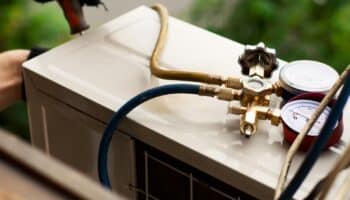We've independently reviewed this article to make sure it's as accurate as we can make it.
To find out more about our article creation and review process, check out our editorial guidelines.
When the outdoor elements are rough, there’s nothing more satisfying than knowing that you’ll be coming home to perfect, climate-controlled paradise.
The air conditioner and the furnace are perhaps the greatest inventions since sliced bread! We wouldn’t trade them for the world, but half of our energy spending comes from heating and cooling our home. Since that’s nearly $1000 dollars for the average household, we all want to find ways to save.
Insulating your air conditioner is a good start! But where do you begin?
Insulating your window air conditioner is a simple task that any home-improvement novices can do themselves. Using foam insulation from the hardware store, you can plug any gaps you find and save money in both summer and winter! You might even give your air conditioner a much needed rest!
How to Get More from Your Window Air Conditioner
For both apartment dwellers and energy-conscious homeowners, the window air conditioner has advantages that bulky central units lack.
They can be used to cool individual rooms as needed, they cost a lot less to install, and you can take them with you when you move (though not every air conditioner works for every room). But like all air conditioners, you can extend their life and raise their efficiency by following some simple rules.
Normally, an air conditioner can lower the temperature of a room by up to twenty degrees Fahrenheit.
Asking most air conditioners to do more is ensuring they’ll overwork themselves and eventually wear down. Window air conditioners have an extra hurdle: cracks and gaps between the unit and the window can let heat in, even while it uses your electricity to cool your room.
This means they have to work harder to achieve the same result. Unless you’re trying to cool off your yard as well, you might want to fix that. Worse, if you leave your air conditioner in the window all year, when winter comes, the warm air in your home will take that same route out, and you’ll face either an imposing heating bill or a frosty house.
Thankfully, these problems can be solved by properly insulating your air conditioner. Insulating your AC is an affordable and cost-saving DIY project anyone can do. In this guide, you’ll learn how to tell if your air conditioner is hiding any energy-stealing gaps, how you can insulate them, and what to do when the summer turns to the cooler days of fall.
The Hidden Cost of Leaking Air
Your home isn’t an airtight box, and that’s a good thing.
We need some air circulation to let out old smells and let in oxygen. However, when we’re running the AC or the furnace, we want to keep that climate-controlled air inside as much as possible. And that’s where your air conditioning unit itself can be the problem. Up to a quarter of the cold (or warm) air inside your home can leak out of the gaps between your window and your air conditioner.
Although that’s a worst-case scenario, these gaps are really a steady leak of your money out into the power company’s pocket. Not to mention that they can let in water when it rains and serve as a door for whatever creepy-crawlies want to check out your interior design skills.
The first way to detect these gaps is simply by looking. A poorly installed window air conditioner or one that’s sagged away from its moorings will show daylight and have a breeze between the unit and the window frame. Other leaks are more insidious. Sometimes, even when you can’t see it, there’s enough of a crack for air to get into. Thankfully, there’s an easy trick to find these. Light a candle lighter and move it carefully around the edge of the air conditioner, being careful not to burn anything.
Any incoming or outgoing air should cause the flame to flicker. Make sure to turn off any fans (and the AC itself) before doing this. Now that you know where the air’s getting through, it’s time to seal it up.
Insulating Your Air Conditioner
The best time to insulate your window air conditioner is when you install it. Following the instructions carefully should mean you place insulation both on the bottom of the window frame and on the bottom of the descending sash that you will lower firmly against the unit. This foam material should be included in the air conditioner’s box, but if for some reason none is provided, you can find it at any home improvement store. Any professional installation should perform this service for you as part of the process.
Of course, most people looking to insulate their air conditioner likely already have it installed. That’s okay!
It doesn’t mean there were problems with the installation. A lot of well-installed window air conditioners can still have, or eventually develop, gaps that need insulation. Using the steps above, identify where the leaks are. Using the same sort of foam insulation as before, cut careful pieces to fill the space between the air conditioner and the window frame. If possible, do this on both the inside and outside. For those in high-rise apartments who can’t reach the outside of their AC, an indoor-only insulation should still be effective to save you money and wear and tear on your now less-busy AC.
If you’re suffering from too much noise getting in, proper insulation is a good start to fixing it. You can cover up the entire thin frame with that same insulation to cut down on a lot of sounds. Even so, an air conditioner is a loud machine when it’s on, and it’s designed to let air (and with it, sound) through. If extra insulation alone doesn’t dull the sounds of the street enough, or if its your AC that’s the source of your noise complaints, it might be time to start reading our guide to quieting a noisy window air conditioner.
Air Conditioner Covers and Wintertime
Even a properly insulated window air conditioner is going to leak more air than a closed window. When possible, the best course of action is to carefully remove and store the unit for the winter months.
Removing a window air conditioner requires two people. This can be done by a pair of dedicated DIYers, but make sure you know what you’re doing. A window air conditioner has enough fragile parts, that you don’t want to store it directly on the floor and you need to cover it with a breathable fabric. If you live in an apartment building, be sure to check your building’s policies. Especially in taller buildings, some apartments have restrictions on how you can remove window air conditioners.
For those of us who can’t remove and store the AC during the winter, there is still a very good way to help keep it safe and insulated—a cover! Before you put it on, though, you’ll want to pop off the outside cover on the air conditioner itself. This will uncover the mechanical workings that make the air conditioner function. Take a sturdy plastic bag and cover everything completely. Pop the cover back on, and you’ve taken a major step to protecting your expensive appliance from the worst winter can throw at it.
Most hardware stores can provide you with a heavy, quilted cover to put on over the outside of the air conditioner. This will not only protect the machine from rain, snow, and hail, but it will also serve as a sort of blanket for your house. An external fabric air conditioner cover will help keep heat from escaping your home. If you’re expecting a storm in summertime, or are just not running your AC for a while, this can protect and insulate in the hot months as well.
Both the internal plastic cover and the external quilted fabric will keep your AC safe from the elements, but there is one thing you need to remember: you have to remove these covers from your air conditioner before turning it on again.
Their function is to prevent air and elements from getting through, and when your AC tries to fight them to pull air from outside to do its job, it can break down quickly. Make sure you know what you’ve put on and in your air conditioner (and any appliance) before turning it on.
Conclusion
We spend enough money running our air conditioner in the summer that we don’t need it costing us more. In both summer and winter, good insulation can make a big difference in our energy bills.
Give your AC a good look, and see if a lighter’s flame can find a breeze. If it does, your bills are just a quick fix from going down.
Thanks for taking the time to visit our site and read this guide! If you have more questions about your air conditioner or anything else, please consider checking out our other articles!









